The Economics and Statistics Division maintains archives of previous publications for accountability purposes, but makes no updates to keep these documents current with the latest data revisions from Statistics Canada. As a result, information in older documents may not be accurate. Please exercise caution when referring to older documents. For the latest information and historical data, please contact the individual listed to the right.
<--- Return to Archive
For additional information relating to this article, please contact:
December 07, 2018LABOUR MARKET TRENDS - NOVEMBER 2018 Nova Scotia's seasonally adjusted employment increased by 200 to 457,700 in November 2018. This marks the fifth consecutive month of employment growth since 2007. The employment level has remained over 450,000 since December 2017.
Compared to October, Nova Scotia’s labour force decreased by 3,000 to 492,500 in November. With labour demand growing slightly and labour supply in decline, the net result was a 0.7 percentage point decline in the seasonally adjusted unemployment rate to 7.0 per cent in November. This is the third lowest monthly unemployment rate since the start of the Labour Force Survey in 1976 (unemployment rates in July 2008 and April 2018 were lower).

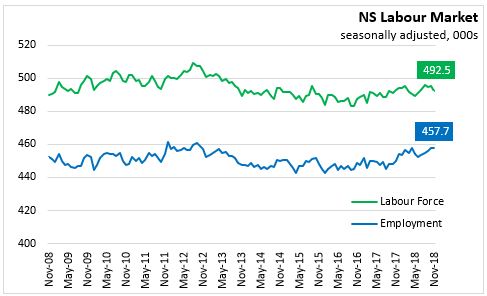
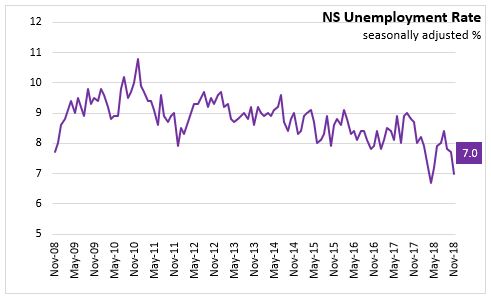
In November, the increase in employment was due to a gain in full-time employment (3,700) more than offsetting the drop in part-time employment (-3,500). Full-time employment has reached its highest point on record at 377,200. Note: Changes in part-time and full-time employment can include the net impacts of changing hours of work within the same position.
Compared with November 2017, the labour force has decreased by 100 while employment is up 8,000. The year-over-year increase in employment includes a rise of 10,800 in full time employment and a decrease of 2,800 in part time employment. The unemployment rate was 1.7 percentage points lower in November 2018 than it was in November 2017.
Year-to Date (January-November 2018 vs. January-November 2017)
Comparing the first eleven months of 2018 to the same period in 2017, there was an increase of 6,700 (1.5 per cent) in the average employment level. Full time employment was up 10,700 (2.9 per cent) while there were 4,000 fewer part-time jobs (-4.7 per cent).
The labour force was up 2,900 (0.6 per cent) compared to the first eleven months of 2017. With labour demand increasing at a faster pace, the net result was a drop in the average unemployment rate of 0.8 percentage points to 7.7 per cent. The labour force participation rate decreased by 0.1 percentage points to 61.7 per cent. The employment rate increased from 56.6 per cent to 57.0 per cent.
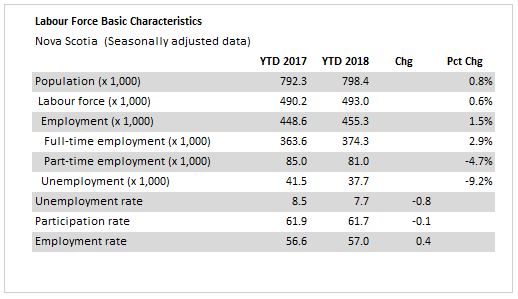
Age Cohorts
Comparing the first eleven months of 2018 to the same period in 2017, the youth cohort (aged 15-24) saw a decrease in population (-600) and increases of 1,300 in labour force and 1,600 in employment. With labour demand increasing at a slightly faster pace than employment, the unemployment rate for 15-24-year olds decreased from 17.1 per cent in the first eleven months of 2017 to 16.3 per cent in the first eleven months of 2018. For November, the youth unemployment rate in Nova Scotia was down 1.8 percentage points from October to 14.1 per cent.
Within the 25-54 age cohort, the population declined 100 over the first eleven months of the year. Employment increased 4,400 while labour force rose by 1,700. With employment increasing faster than the labour supply, there was a 0.9 per cent decline in the unemployment rate for this cohort, dropping to 6.0 per cent for the first eleven months of 2018. The November unemployment rate for these core aged workers was 5.7 per cent, a decline of 0.2 percentage points compared to October.
The cohort aged 55 and older saw a population increase of 6,800 over the first eleven months of last year as well as a labour force decreases of 100 and an employment gain of 600. With labour demand growing faster than the labour supply, there was a decrease in the unemployment rate to 6.6 per cent (compared to 7.3 per cent over the first eleven months of 2017). The November unemployment rate for the age group 55 and older was 6.4 per cent, down 0.8 percentage points from October.
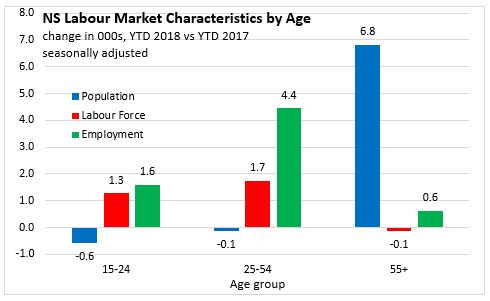
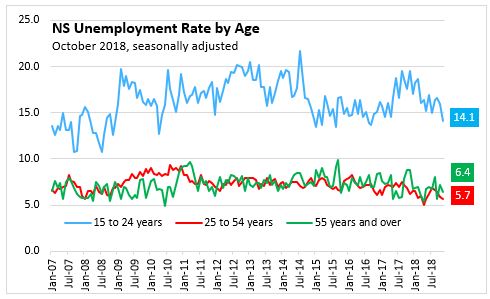
Sectors
Looking at results by class of worker for the first eleven months of 2018, employment increase for the private sector (6,400) and self employment (1,600) were the main sources of year-to-date employment growth, offsetting a decrease in public sector employees (-1,400).
Among goods-producing sectors, the first eleven months of 2018 saw employment growth concentrated in manufacturing (+800) and construction (+1,700) offsetting declines in forestry, fishing, hunting, mining and oil and gas (-1,200). Services-producing employment increased by 5,000 for the first eleven months of 2018 over the same period in 2017. The largest increases come from accommodation/food sectors, information/culture/recreation sectors, education, and wholesale/retail trade. The largest decline came from health care, with smaller declines in finance/insurance, professional/technical services and business support services (including call centres).
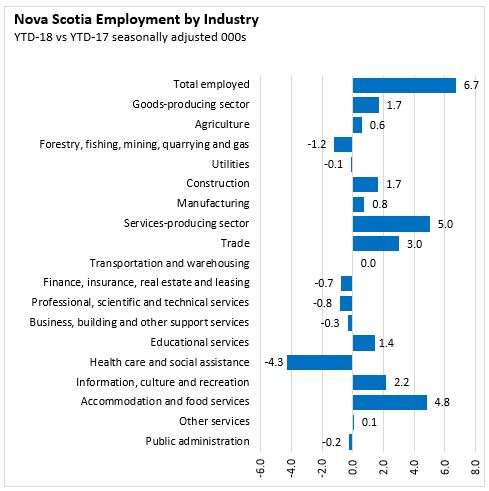
Regions (3 month moving average, January-November 2018 vs. January-November 2017)
Comparing the 3-month average (unadjusted) for the first eleven months of 2018 with the same period in 2017, shows that Halifax and Southern Nova Scotia had falling unemployment rates because employment gains outstripped growth in labour supply. The Cape Breton region had declines in both labour demand and labour supply, with employment falling slightly more quickly to put upward pressure on the unemployment rate. The North Shore region’s stable unemployment rate was from employment and labour force shrinking at the same pace. The Annapolis Valley reported a slightly faster decline in the labour supply, outpacing the drop in employment to reduce the unemployment rate.
The Cape Breton region reported a decline of 500 for employment along with a decline of 300 in the labour force. A faster decline in employment than labour force pushed the YTD unemployment rate up 0.4 percentage points to 14.6 per cent.
For the North Shore region, the labour force declined by 2,700 and employment declined by 2,400. With employment and labour force falling at about the same pace, the unemployment rate remained stable at 8.9 per cent.
The Annapolis Valley reported a decline of 1,900 for employment along with a decline of 2,300 for the labour force. As the labour force declined more quickly, there was also a slight drop in the number of unemployed workers. The net result was drop in the average unemployment rate of 0.4 percentage points to 7.2 per cent.
The Southern region saw an increase of 2,700 in employment along with an increase of 1,100 in the labour force. With labour force and employment increasing (and unemployment declining), the YTD unemployment rate was down 3.2 percentage points to 6.8 per cent.
Halifax experienced an increase in employment of 8,700 along with an increase in the labour force of 7,800. With the labour demand growing faster than labour supply the unemployment rate dropped by 0.5 percentage point to 6.3 per cent in Halifax. The seasonally adjusted (3 month moving average) unemployment rate declined from 6.3 per cent in October to 5.4 per cent in November.
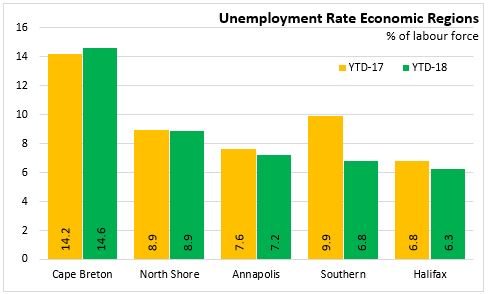
Provincial Comparisons
The Nova Scotia unemployment rate was 7.0 per cent in November 2018, down from 8.7 per cent a year ago. The Canadian unemployment rate was 5.6 per cent, down from 5.9 per cent one year ago. Canada’s unemployment rate is at its lowest level on record since the start of the Labour Force Survey.
Compared to the same month one year ago, two provinces noted slightly higher unemployment rates (Ontario and Manitoba). All Atlantic provinces posted declines in unemployment rates compared to November 2017. The lowest unemployment rate among the provinces this month was in British Columbia (4.4 per cent) while the highest was in Newfoundland and Labrador at 12.2 per cent.
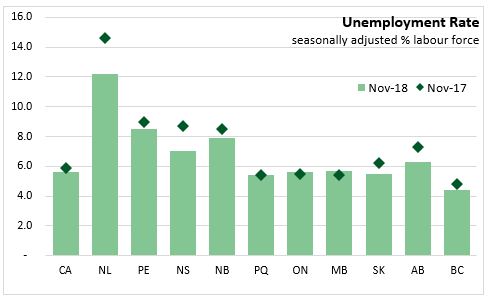
Comparing January-November 2018 with the same period in 2017, employment increased 1.3 per cent in Canada, with gains in all provinces. The largest gains were in in Prince Edward Island (+3.2 per cent). Employment growth was lowest in Newfoundland and Labrador, and Saskatchewan (+0.3%).

National Comparisons: Cities
The seasonally adjusted unemployment rate for the Halifax Census Metropolitan Area (CMA) in November was 6.2 per cent (3 month moving average). Guelph, Ontario (3.0 per cent) had the lowest unemployment rate among CMAs, while the highest was in St. John's (8.1 per cent).
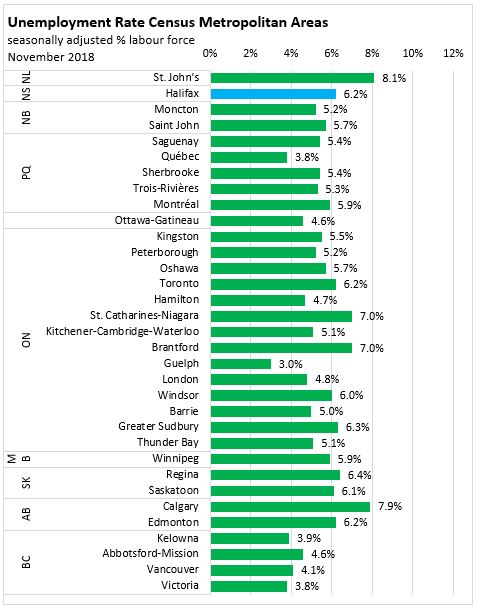
The seasonally adjusted employment rate for the Halifax CMA was 64.2 per cent, up slightly from last month. Saguenay had the lowest employment rate (53.4 per cent), while Edmonton had the highest (68.4 per cent).
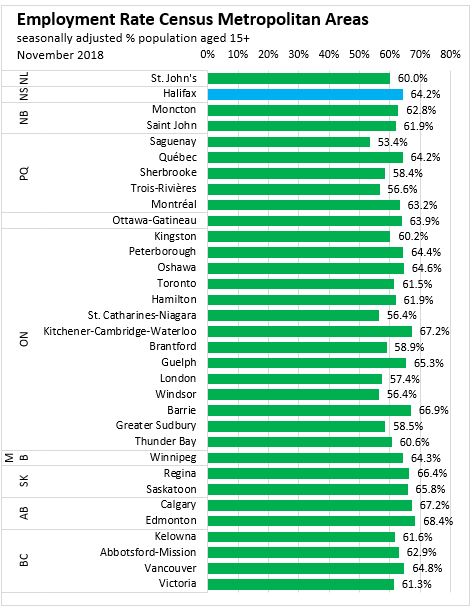
Halifax’s employment (3 month moving average) for November was up 0.4 per cent compared to the October result. The largest gain among CMAs was in Peterborough, Ontario, where employment rose by 2.7 per cent.
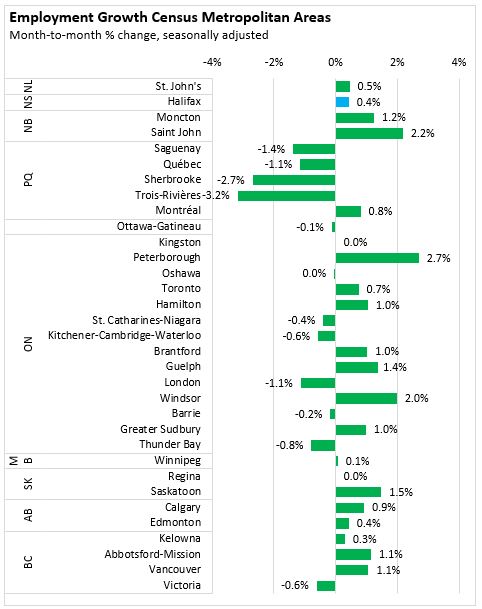
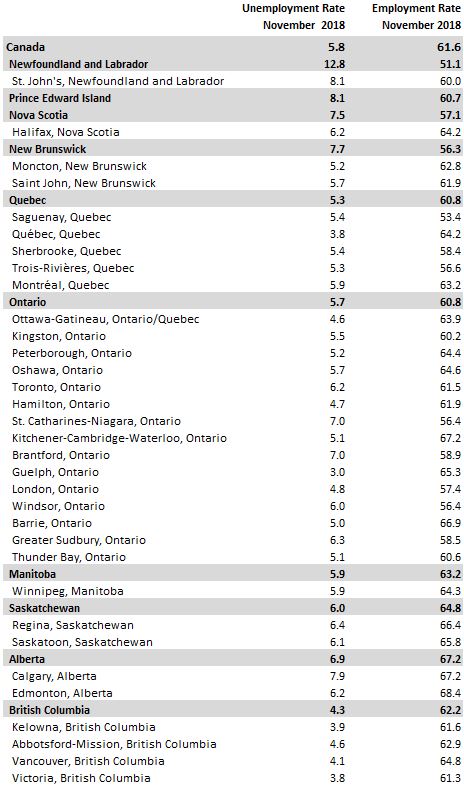
Note: Seasonally adjusted, 3 month average.
<--- Return to Archive